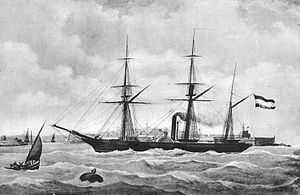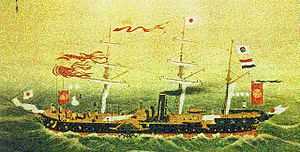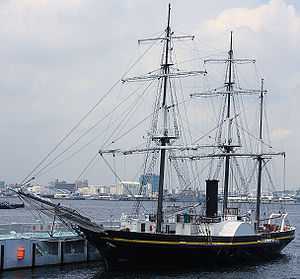Japanese barque Kanko Maru
 The Kankō Maru, Japan's first steam warship, 1855 | |
| Career | |
|---|---|
| Name: | Soembing |
| Owner: | Royal Netherlands Navy |
| Laid down: | 1852 |
| Commissioned: | 1853 |
| Fate: | Presented to Japan 1855 |
| Career | |
| Name: | Kankō Maru |
| Acquired: | 1855 |
| Decommissioned: | 1876 |
| Fate: | scrapped |
| General characteristics | |
| Displacement: | 400 t (394 long tons) |
| Length: | 66 m (216 ft 6 in) o/a |
| Beam: | 8 m (26 ft 3 in) |
| Draught: | 4.2 m (13 ft 9 in) |
| Propulsion: | Coal-fired steam engine, 150 hp |
| Sail plan: | 3-masted sail |
| Armament: | 6 cannon |
The Kankō Maru (観光丸 Kankō-maru) was Japan's first steam warship. The ship was a 3-masted top sail schooner (Jackass-barque), with an auxiliary coal-fired steam engine turning a side paddlewheel. It was given to Japan by the Dutch.
History
Following the forced ending of Japan's national seclusion policy in 1854 by Commodore Matthew Perry of the United States, the Tokugawa shogunate turned to the Dutch, their sole Western trading partners in the previous 200 years, for the procurement of modern ships to counter the perceived threat posed by the West and its "black ships".[1]
Janus Henricus Donker Curtius, head of the Nederlandsche Handel-Maatschappij in Japan facilitated the purchase. Since time was needed to import the ships, Donker Curtius asked for one of the warships of the Royal Netherlands Navy stationed in the Netherlands East Indies to be presented to the Japanese government.[2]
The Dutch warship named Soembing (スームビング), the name of an Indonesian volcano, was sent with Naval captain Gerhardus Fabius to introduce the Japanese to navigation techniques in 1854, and the ship was formally presented to the government of Shogun Tokugawa Iesada at Nagasaki in the name of the Dutch King, Willem III in 1855. The gift was the subject of heated debates within the government. She was renamed Kankō Maru (観光丸), after a line in the I Ching : Kankoku shi kō (觀國之光 to view the light of the country).

Kankō Maru was assigned to be a training ship to the newly formed Nagasaki Naval Training Center, under Director Nagai Naoyuki (永井尚志). At this time, 22 Dutch sailors, including Lieutenant junior G. C. C. Pels Rijken provided training, and this training was continued by Lieutenant H. van Kattendijke who arrived in Japan on the Kanrin Maru. This was the first time that the Japanese had received formal military training from the Dutch.[3]
She was then transferred to the new Naval Training Center in Edo in April 1857, with a Japanese-only crew of 103 students. Following the Meiji Restoration, she was taken over the by Meiji government and became one of the first ships of the fledgling Imperial Japanese Navy. She remained based at the Imperial Japanese Naval Academy at Tsukiji, Tokyo until she was scrapped in 1876.
Replica

A faithful replica of the original Kankō Maru was built in at the Verolme Shipyards in the Netherlands in 1987 based on the original plans for the Soembing preserved at the National Maritime Museum in Amsterdam. She was used as a tourism ship in the Huis Ten Bosch theme park in Sasebo, Nagasaki, and has been sailing along the coast of Japan since. The ship requires as 14-man crew, and can carry up to 300 passengers on short day cruises.
Spaceship project
Kankoh-maru is also the name of a Japanese spaceship project for space tourism.
See also
References
- ↑ Hendrik Caspar Romberg's account of the Sangoku-maru is a scant record of the brief attempt by the Tokugawa shogunate to create a sea-going vessel in the 1780s. The ship sank; and the tentative project was abandoned when the political climate in Edo shifted. See Timon Screech. (2006). Secret Memoirs of the Shoguns: Isaac Titsingh and Japan, 1779-1822, pp. 48-49., p. 48, at Google Books
- ↑ De Goey, p. 10
- ↑ National Diet Library
Sources
- (Dutch) Zijne Majesteits raderstoomschip Soembing overgedragen aan Japan. De drie diplomatieke reizen van kapitein G. Fabius ter opening van Deshima en Nagasaki in 1854, 1855 en 1856. Onder redactie van J. Stellingwerff. Linschotenvereniging, 1988. 175 p.
External links
- Spaceship Kankoh Maru (Japanese)
- Soembing/Kanko Maru
- De Goey, F. (2008) Western entrepreneurs and the opening of Japanese ports (c. 1858-1868)
| ||||||||||||||||||||||||||||||||||||||||||||||||||